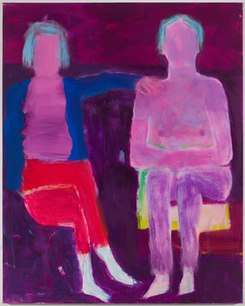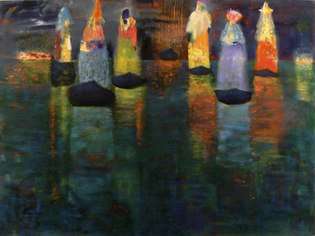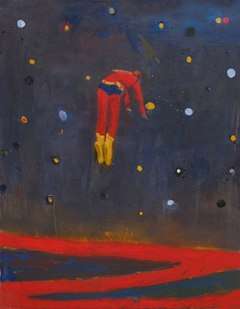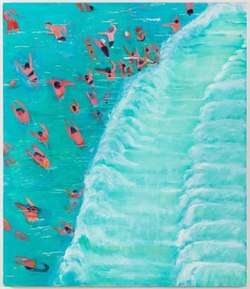Katherine Bradford
Katherine Bradford (born 1942) is an American artist based in New York, best known for paintings of swimmers, superheroes and ships that critics describe as simultaneously representational and abstract, luminous, and richly metaphorical.[1][2][3][4] She began her career as an artist relatively late in life and has achieved her widest recognition in her seventies, through New York gallery shows at CANADA, Sperone Westwater, and Edward Thorp.[5][6][7] Writing about her work's adventurousness, open-ended process, refusal of canonical either/or conundrums (representational-abstract, formal-narrative) and relevance to younger artists, critic John Yau called Bradford, among others, "an important figure in an alternative history that has yet to receive the attention it deserves."[8][1]
Katherine Bradford | |
|---|---|
| Born | 1942 New York City, New York, United States |
| Nationality | American |
| Education | SUNY Purchase, Bryn Mawr College |
| Known for | Painting |
| Style | Figurative art |
| Spouse(s) | Peter A. Bradford (divorced) Jane O'Wyatt |
| Awards | John S. Guggenheim Fellowship, Joan Mitchell Foundation, American Academy of Arts and Letters, Pollock-Krasner Foundation |
Bradford has exhibited internationally and in shows at the Modern Art Museum of Fort Worth (solo), MoMA PS1, Brooklyn Museum, Pennsylvania Academy of Fine Arts, and University of the Arts (Philadelphia), among others.[9][10] She has received awards from the John Simon Guggenheim, Joan Mitchell and Pollock-Krasner foundations and the American Academy of Arts and Letters,[11][12][13][14] and her work belongs to the public art collections including those of the Metropolitan Museum of Art, Brooklyn Museum, Dallas Museum of Art, Menil Collection, and Portland Museum of Art.[15][16][17][18]

Bradford lives with her spouse Jane O'Wyatt, dividing time between New York City, her painting studio in Williamsburg, Brooklyn, and Brunswick, Maine.[19][20] Her children are writer and filmmaker Arthur Bradford and Cambridge University law professor Laura Bradford.[21][22][23]
Early life and career
Bradford was born in 1942 in New York City and grew up in Connecticut.[24] Unlike many artists, she was not inclined toward artmaking as a child; her mother discouraged the "bohemian" life of the arts, despite Bradford's grandfather, Jacques André Fouilhoux, being a prominent architect.[25] After earning a BA at Bryn Mawr College, Bradford's life took a fairly conventional (1960s) path, marrying Peter A. Bradford and raising twins born in 1969.[26][27][28][29] When the family moved to Maine in the early 1970s, she became interested in the art community there, which included Lois Dodd and Yvonne Jacquette, among others.[25][26] Without training, she began creating abstract work focused on markmaking and the materiality of paint and related to the landscape tradition.[19][27][24] She also co-founded the Union of Maine Visual Artists (1975) and wrote art reviews for The Maine Times.[26][19]
In 1979, despite considerable disapproval from her family, Bradford moved to New York City as a single mother to pursue art in closer contact with contemporary painting discourse, eventually enrolling in graduate studies at SUNY Purchase (MFA, 1987); she met her future spouse, Jane O'Wyatt, in 1990.[27][30][21][28] In the decade after earning her degree, she gradually attracted recognition through solo exhibitions at the Victoria Munroe (New York), Zolla/Lieberman (Chicago), and Bernard Toale (Boston) galleries, and group shows at the Portland Museum of Art, Weatherspoon Art Museum and The Drawing Center.[31][32][33][34] In the 2000s, Bradford has gained wide attention, exhibiting at the Modern Art Museum of Fort Worth (2017), the CANADA, Sperone Westwater and Edward Thorp galleries in New York, Galerie Haverkampf (Berlin), Adams and Ollman (Portland), and Campoli Presti (London), among others.[35][5][36][9][37][38]
In addition to making art, Bradford taught at Illinois State University, Ohio State University and SUNY Purchase, before joining the faculties at Fashion Institute of Technology (FIT) (1995–2011) and Pennsylvania Academy of Fine Arts (1997–2012).[22][39][26] She later taught at the Skowhegan School of Painting and Sculpture (2009) and Yale School of Art (2016–7).[22]
Work
Bradford is best known for direct, casual, color-saturated paintings of swimmers, boats, and caped flying figures that are distinguished by their deft paint handling, rich color-field surfaces, theatrical sense of light, and compellingly oblique themes and narratives.[19][6] Critics suggest that Bradford weights color, iconography and narrative equally in her paintings and defers conclusion for exploration, creating dense formal and metaphorical possibilities.[2][1][40]
Art in America's Robert Berlind characterizes her method as "predicated on a trust in possibilities beyond her conscious intentions or formal inclinations, and on a responsiveness to what shows up on the canvas."[41] Bradford has said that unlike traditional figurative painters, she does not begin with a plan, but rather draws on her ongoing vocabulary of forms, discovering each image through the painting process and intuition.[42][43] Artcritical editor David Cohen writes that she combines "the peculiar poetic charm and nonchalance of provisional painting with the energy, seriousness, and resolve of classic abstract painting"; he compares her formal evolution to "the high-abstraction-to-low-realism trajectory of Philip Guston" while differentiating her treatment of subjects as romantic, heartfelt, and shot through with whimsical or poignant humor.[3]
Early painting
Bradford's early, modestly scaled paintings were largely abstract, employing irregular grids and rows of pictographic dots, spirals and crude letterforms set against multilayered, vaporous surfaces akin to Rothko's meditative spaces.[31][44][45][33][34] New York Times critic Roberta Smith described them as "beautifully made, sincerely felt, and distinguished by a special talent for schematizing nature into small, ruggedly made abstractions that are at once poetic and humorous."[44] In Art in America, Stephen Westfall wrote that they charted "a laconic course between abstraction, representation and collage," while Eileen Myles situated Bradford among a group of mainly female artists "reconstituting painting" through "wit, subversion and bad geometry."[31][46] In her late 1990s work, Bradford moved closer to iconographic representation, depicting box forms and figures with bold, heavy lines and a comedic or darkly humorous tone.[47][48][49]

Mid-career painting: ships and boats
Bradford gained wider attention with work in the 2000s centered on what John Yau calls the unlikely "minor, masculine genre of marine painting": ethereal images of ocean liners, dubious sailboats, sea battles, whaling scenes and vulnerable figures that suggest spiritual or intellectual illumination emerging out of darkness (e.g., Lake Sisters and Traveler, both 2004).[1][50][52] Critics characterize these paintings as both mysterious and direct, with simple, ambiguously scaled and combined elements, fluid sea-sky realms, and complex surfaces whose abraded brushstrokes, dabs and scumbling evoke rather define form.[49][4][53][27] James Kalm describes them as combining "New England romantic realism with transparent fields of zippy new age color and subversive figuration," unified by unfussy directness and "the facility of a slippery brush."[50]
John Yau labels works in Bradford's 2007 show (Edward Thorp), such as Men in Bay and Desire for Transport—a flotilla of seven boats floats on a flecked, blue-green sea carrying mysterious gowned figures—as "breakthrough paintings" that synthesize "the bluntness of primitive painting, the directness of gestural mark-making [and] the gamut of expressionism" to create a sense of inexhaustibility and expectancy.[53][8][41] New York Times critic Ken Johnson writes that Bradford's ships suggest "utopian collectivity, promising voyages of kindred spirits to unknown shores."[54]
Critics observe that Bradford's later marine paintings move further from representational "picture-space" toward more open-ended, abstract "painting-space."[55][1][56] In this work, unearthly lit, foreshortened, monolithic ships read equally as abstract, irregular trapezoids—slyly alluding to Minimalist sculpture—against grounds that simultaneously function as moody color fields and slabs of pure color (e.g., Titanic Orange Sea and Sargasso, both 2012).[1][55][57]

Superman paintings
In the early 2010s, Bradford began painting plunging figures and idiosyncratic, caped "Superman" characters, set against creamy color fields or rubbed, atmospheric matte skies marked with star bursts and zigzags suggesting paths (e.g., Superman Responds, Night, 2011).[57][41][3] Her superhero images are described variously as "luminous and sumptuously tactile, sometimes goofy,"[54] frumpy, vulnerable, genderless, and caught in a peculiar, tentative state between flying and diving.[55][21][41] Bradford captures them in style that Robert Berlind calls "at once offhand and emblematic"; David Cohen writes that in Superman Responds (2011), she conveys "a convincing if gender-bent voluptuousness" in a few carefree-seeming dabs with "disconcerting observational acumen" and anatomical precision.[41][3]
Writers differentiate the Superman paintings from Pop, cartoony or ironic work in both appearance and attitude, noting their qualities of heartfelt warmth, vulnerability, dream-like reverie and metaphorical elasticity.[8][41][55] John Yau interprets them as alternative, knowing meditations on heroism, history and masculinity as "simultaneously powerful and impotent, idiotic and funny";[8] others similarly suggest that Bradford is dismantling icons (both heroes and ships).[55][58] Painter Caroline Wells Chandler and other writers, however, suggest they represent new symbols of strength in vulnerability, visionary individualism, painterly and personal exploration, and perhaps, Bradford herself.[59][3][54]
Later painting: swimmers and figurative works
Bradford's later work (e.g., "Fear of Waves" show, 2016) has evolved toward larger, more vibrant work, that Yau writes "transform[s] the whimsical into the catastrophic, its polar opposite, without losing [its] offhand humor" and conveys a new gravitas.[60][61] Often painted in water-soluble acrylic—ideal for mimicking the effects of water in images of swimmers, bathers and surfers—these paintings take greater formal risks, with complex compositions of multiple figures and divided grounds of otherworldly, nocturnal planetary-oceanic environments.[62][61][63][60]

In the lyrical, near-monochrome painting Blue Swimmers (2015), Bradford submerges and crops ghostly, awkwardly human figures within washy fields of blue or green, complicating figure-ground relationships while alluding to themes of birth, life, and possibly, death.[62][64][60][65] Other paintings, like the diagonally divided, vertical Fear of Waves (2016), introduce an element of uncertainty or calamity whose specific threat and outcome remains a mystery; in bird's-eye view, it depicts a crowd of swimmers fleeing giant, leftward-moving waves toward through a turquoise impasto, their insignificance against the unfathomable evoking pathos.[64][5][61][60]
Critics such as Lilly Wei identify Bradford's "Friends and Strangers" (2018) and "Legs and Stripes" (2019) shows as significant departures in palette, process and subject, including resonant, collective themes such as race, sexuality, gender and identity.[2][36][66][38] These paintings, some of her most monumental, are distinguished by their vibrant summery pinks, magentas, purples and yellows, use of thick (out)line to indicate more prominent figures (e.g., Lunch Painting or Yellow Dress, 2018), and wider subject range (e.g., Waiting Room, a large luncheon, a seated couple).[2][36][66][28][67]
Paintings such as Olympiad (2018)—in which Bradford experimented with colors mixed with florescent magenta paint—feature improbable arrangements of differently attired figures (some floating horizontally), that reveal her interest in subjects as equally split between how they fit together visually, as abstract compositional elements, and socially as potential communities.[43][28][68] Works such as Choice of Heads (2019) and Couple No Shirts (2018) expand on the theme of identity, respectively depicting a figure literally choosing among heads and a couple whose somewhat androgynous, faceless appearance implies universality while revealing the operation of categorization and assumption in looking.[28][66][38]
Awards and collections
Bradford has been recognized with awards from the John Simon Guggenheim Memorial Foundation (2011), Joan Mitchell Foundation (2012), American Academy of Arts and Letters (2011, 2005), and Pollock-Krasner Foundation (2000).[26][12][13][14] Her work belongs to the public collections of the Metropolitan Museum of Art,[15] Brooklyn Museum,[16] Dallas Museum of Art,[17] Menil Collection, Portland Art Museum,[18] Addison Gallery of American Art,[69] Hall Art Foundation,[70] Pennsylvania Academy of the Fine Arts,[71] Portland Museum of Art (Maine),[72] and several college museums, among others.
References
- Yau, John. "The Bigger Picture, Bradford’s Museum Exhibit at Bowdoin College," Hyperallergic, August 25, 2013. Retrieved April 2, 2020.
- Wei, Lilly. "Katherine Bradford: Friends and Strangers," The Brooklyn Rail, October 2018. Retrieved April 6, 2020.
- Cohen, David. "New Hero," artcritical, May 26, 2012. Retrieved April 2, 2020.
- Johnson, Ken. "Everywhichway," The New York Times, July 7, 2006. Retrieved April 2, 2020.
- Panero, James. "Gallery Chronicle (February 2016)," The New Criterion, February 2016. Retrieved April 6, 2020.
- Zevitas, Steven. "15 Artists to Watch in 2015 (+3)," Huffington Post, December 12, 2014. Retrieved April 6, 2020.
- Belcove, Julie L. "Katherine Bradford," Elle Décor, July-August 2017, p. 58–9.
- Yau, John. "No More Garden Variety Avant-Garde Has-Beens," Hyperallergic, April 22, 2012. Retrieved April 2, 2020.
- Hohmann, Silke. "Katherine Bradford in Berlin," Monopol: Magazin für Kunst und Leben, Dezember 2018.
- MoMA PS1. "Orpheus Selection: In Search of Darkness," Exhibitions. Retrieved April 6, 2020.
- Artforum. "2011 Guggenheim Fellows Announced," News, April 7, 2011. Retrieved April 6, 2020.
- Joan Mitchell Foundation "Katherine Bradford," Artist Grants. Retrieved April 2, 2020.
- Pollock-Krasner Foundation. "Katherine Bradford," Artists. Retrieved April 6, 2020.
- American Academy of Arts and Letters. "Katherine Bradford." Retrieved April 6, 2020.
- Metropolitan Museum of Art. "Katherine Bradford," Collection. Retrieved April 6, 2020.
- Brooklyn Museum. "Katherine Bradford," Collection. Retrieved April 6, 2020.
- Dallas Museum of Art. "Prom Swim, Green by Katherine Bradford," Collections. Retrieved April 6, 2020.
- Portland Art Museum. "Katherine Bradford," Online Collections. Retrieved April 6, 2020.
- Konau, Britta. "The Humor and Humanity of Katherine Bradford, Part 1," The Free Press (Maine), October 24, 2012. Retrieved April 2, 2020.
- McMahon, Katherine. Habitat: Fair Thee Well—Visits With Artists in Their Studios Before Independent New York," ARTnews, March 2, 2017. Retrieved April 6, 2020.
- Bradford, Arthur. "Interview: Katherine Bradford," Artfridge, December 15, 2015. Retrieved April 2, 2020.
- The New York Times. "Laura Bradford, David Kirkpatrick," Weddings, The New York Times, September 21, 2003. Retrieved April 2, 2020.
- University of Cambridge. Laura Bradford, Faculty of Law. Retrieved April 12, 2020.
- Biswas, Allie. "Wonderful Worlds," Glass, Summer 2017, p. 124–9.
- Samet, Jennifer. "Beer with a Painter: Katherine Bradford," Hyperallergic, September 17, 2016. Retrieved April 6, 2020.
- John Simon Guggenheim Memorial Foundation. "Katherine Bradford," Fellows. Retrieved April 2, 2020.
- The Brooklyn Rail. "Katherine Bradford with Chris Martin and Peter Acheson," The Brooklyn Rail, May 2007. Retrieved April 6, 2020.
- Abrams, Loney. "I'm not going to fool around": An Interview with Painter Katherine Bradford," Artspace, July 12, 2019. Retrieved April 6, 2020.
- "WEDDINGS/CELEBRATIONS; Laura Bradford, David Kirkpatrick". The New York Times. September 21, 2013.
- Bradford, Arthur. "How About a Little Badass Inspiration" Medium, April 20, 2016. Retrieved April 6, 2020.
- Westfall, Stephen. "Katherine Bradford at Victoria Munroe," Art in America, May, 1990.
- Cyphers, Peggy. "Katherine Bradford," Arts Magazine, January 1990.
- Artner, Alan G. "Katherine Bradford paintings convey much about an artist's workaday life," Chicago Tribune, February 6, 1992.
- Stagen, Nancy. "Painters stretch the possible – Robert Ripps, Kathleen Bradford, Robert Kelly," The Boston Globe, November 11, 1993.
- Birnbaum, Molly. "Katherine Bradford at Edward Thorp," ARTnews, Summer 2007.
- Yau, John. "The Amazing Katherine Bradford," Hyperallergic, September 30, 2018. Retrieved April 2, 2020.
- Butler, Sharon. "Katherine Bradford's night vision," Two Coats of Paint, May 10, 2018. Retrieved April 2, 2020.
- Hunt, Andrew. "Katherine Bradford," Artforum (London), October 2019. Retrieved April 6, 2020.
- Pennsylvania Academy of Fine Arts. "Visiting-Artist: Katherine Bradford." Retrieved April 6, 2020.
- Yau, John. "The Nocturnal Worlds of Katherine Bradford," Hyperallergic, January 22, 2017. Retrieved April 2, 2020.
- Berlind, Robert. "Katherine Bradford," Art in America, October 2012. Retrieved April 6, 2020.
- Konau, Britta. "The Humor and Humanity of Katherine Bradford, Part 2," The Free Press (Maine), November 11, 2012. Retrieved April 2, 2020.
- Vogel, Maria. "Katherine Bradford Embraces an Unconstrained Practice," Art of Choice, May 30, 2019. Retrieved April 6, 2020.
- Smith, Roberta. "Katherine Bradford," The New York Times, October 27, 1989, p. C30. Retrieved April 2, 2020.
- Braff, Phyllis. "In the Choices of Albee, Imagination Prevails," The New York Times, February 11, 1990. Retrieved April 2, 2020.
- Myles, Eileen. "Katherine Bradford at David Beitzel Gallery," Art in America, June 1993.
- Maine Sunday Telegram. Review, Maine Sunday Telegram, August 29, 1999.
- Lombardi, Dominick D. "Inaugural exhibition for Gallery in Beacon," The New York Times, April 22, 2001, p. WC14. Retrieved April 2, 2020.
- Maine, Stephen. "Ether Nights at Sarah Bowen Gallery," Artnet, February 2005. Retrieved April 6, 2020.
- Kalm, James. "Katherine Bradford, Sarah Bowen Gallery," The Brooklyn Rail, February 2005. Retrieved April 6, 2020.
- Fyfe, Joe. "Katherine Bradford at Sarah Bowen," Art in America, May 2005.
- Yau, John. "Katherine Bradford, By Life and by Land, Recent Paintings," The Brooklyn Rail. June 2007. Retrieved April 6, 2020.
- Johnson, Ken. "Katherine Bradford: ‘New Work'," The New York Times, May 3, 2012, p. C28. Retrieved April 2, 2020.
- Stopa, Jason. "Kathleen Bradford with Jason Stopa," The Brooklyn Rail, April 2, 2012. Retrieved April 6, 2020.
- Plagens, Peter. "On Supermen and Airships," Wall Street Journal, April 27, 2012.
- Stillman, Nick. "Katherine Bradford, Bowdoin College Museum of Art," Artforum, October 2013. Retrieved April 6, 2020.
- Kimball, Whitney. "Four Shows NYC, Aggro Crag at BOSI Contemporary," New American Paintings, September 21, 2012. Retrieved April 6, 2020.
- Chandler, Caroline Wells. "Caroline Wells Chandler on Katherine Bradford," Painters on Paintings, October 3, 2016. Retrieved April 2, 2020.
- Yau, John. "Katherine Bradford Dives In," Hyperallergic, January 17, 2016. Retrieved April 2, 2020.
- Butler, Sharon. "Starry Night: Katherine Bradford at Canada," Two Coats of Paint, January 20, 2016. Retrieved April 2, 2020.
- Steadman, Ryan. "Diving into Katherine Bradford’s Paintings at Canada," The New York Observer, January 26, 2016. Retrieved April 6, 2020.
- The New Yorker. "Katherine Bradford," January 20, 2017.
- Hirsch, Faye. "Katherine Bradford," Art in America, April 2016. Retrieved April 6, 2020.
- Pardee, Hearne. "Katherine Bradford, Fear of Waves," The Brooklyn Rail, February 3, 2016. Retrieved April 6, 2020.
- Kardon, Dennis. "Subtle Ambiguities: Katherine Bradford at Canada," artcritical, October 12, 2018. Retrieved April 6, 2020.
- Campoli Presti. "Katherine Bradford," Retrieved April 13, 2020.
- Heinrich, Will. "What to See in New York Art Galleries Right Now," The New York Times, March 15, 2019, p. C14. Retrieved April 2, 2020.
- Addison Gallery of American Art. "Katherine Bradford, Island Ferry," Collection. Retrieved April 6, 2020.
- Hall Art Foundation. Katherine Bradford, Beautiful Lake Collection. Retrieved April 2, 2020.
- Pennsylvania Academy of Fine Arts. "Katherine Bradford," Collection. Retrieved April 6, 2020.
- Portland Museum of Art. "Katherine Bradford, Flying Woman, 6X," Collections. Retrieved April 6, 2020.
External links
- Katherine Bradford Guggenheim Fellowship page
- Kathleen Bradford with Jason Stopa, Interview, The Brooklyn Rail
- Interview with Katherine Bradford, Jennifer Samet, Hyperallergic
- Katherine Bradford "Friends and Strangers" at Canada, video, James Kalm, 2018
- Katherine Bradford "Fear of Waves" at Canada, video, James Kalm, 2016
- Katherine Bradford "By Life & By Land" at Edward Thorp Gallery, video, James Kalm, 2007
- Katherine Bradford artist page, CANADA
- Katherine Bradford artist page, Adams and Ollman